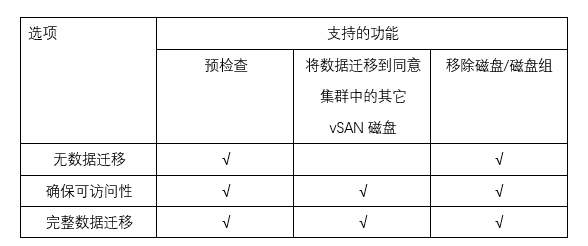Managing host disks
This topic describes how to manage host disks through wizards, including replacing or removing vSAN disks.
Replacing a vSAN disk
Replace an existing disk used as a vSAN datastore with a new one.
Before you begin
Ensure that the target disk has already been used as a vSAN datastore.
Procedure
In the host hardware topology, select the target disk.
Click the Replace Disk button to display the Replace Disk wizard.
In the first step of Verification, the location of the target disk in the hardware topology and its details will be displayed. The hardware topology highlights the target disk and other members of the disk group where it is located; the target disk details show its detailed information. Check whether the target disk information is correct and click Next.
In the second step of Migrate Data, select one of the following required modes for disk data migration from the drop-down list of Select the data migration mode:

ClickExecute Now, wait for the process of removing the disk from the disk group or disk pool to complete, and click Next.
In the third step of Replace Disk, the hardware topology of the host will be displayed, with the target disk highlighted. Click below the topology mapas well asHost LED, to assist remote personnel to identify the target disk and unplug the target disk from the disk slot. Click **Disk LED and Host LED** below the topology to assist remote personnel in identifying the target disk and pulling it out from the disk slot.
Insert a new disk into the same disk slot and click Detect New Disk. Wait for the detection process to complete. Information about the new disk and old disk will be displayed in the table below. Please confirm that the information is correct.
ClickAutomatically claim new disks, automatically adds the new disk to the disk group. :::note Note:
If the disk being replaced is the cache disk or the last capacity disk in the disk group, the entire disk group will be removed. If you click Automatically declare new disks at this time, the system will match other disks in the removed disk group and automatically rebuild a new disk group.
:::
Click Finish to complete the disk replacement.
Remove vSAN disk
Remove disks from the server that are used as vSAN data storage
Before you begin
The target disk must be a disk already used by vSAN datastore
After deduplication and compression are enabled on a vSAN host, if the cache disk or the last capacity disk is removed from the disk group, the entire disk group is removed. If necessary, manually recreate a disk group.
A physical disk removed from the slot will be represented by a dotted line and its status will be empty.
Procedure
In the host hardware topology, select the target disk.
Click the Remove Disk button to display the Remove Disk Wizard.
In the first step of Verification, the location of the target disk in the hardware topology and its details will be displayed. The hardware topology highlights the target disk and other members of the disk group where it is located; the target disk details show its detailed information. Check whether the target disk information is correct and click Next.
In the second step of Migrate Data, select one of the following required modes for disk data migration from the drop-down list of Select the data migration mode:

ClickExecute immediately, wait for the process of removing the disk from the disk group to complete, clickNext step.
In the third stepRemove diskOn the page, the host’sHardware topology diagram, the hardware topology diagram will be highlightedtarget disk, you can click below the topologyDisk LEDas well asHost LED, to assist remote personnel to identify the correct disk and perform removal operations.
Click Finish to complete disk removal.
Add vSAN disk
Add disks in the server that are not used for vSAN data storage
Before you begin
The target disk must be an unclaimed disk.
Procedure
In the host hardware topology, select the target disk.
Click the Add Disk button to display the Add Disk Wizard.
In the first step of Verification, the location of the target disk in the hardware topology and its details will be displayed. The hardware topology diagram will be highlightedtarget disk;Target Disk Details displays the target disk details and automatically checks whether the target disk is allowed to be added to the disk group or vSAN datastore. Check whether the target disk information is correct and click Next.
Step 2operateThe page will display the host’sDisk group list,existDisk group listSelect a disk group and clickadd disk, wait for the process of adding the disk to complete.
Note:If the current host is in an ESA cluster,operateThe host will not be displayed on the page.Disk group list, you can click directlyadd disk.
Click Finish to complete disk addition.
Switch disk LED
You can turn the disk's LED on or off.
Before you begin Select a disk.
Procedure
- ClickDisk LED: open , turn on the disk LED.
- ClickDisk LED: close, turn off the disk LED light.